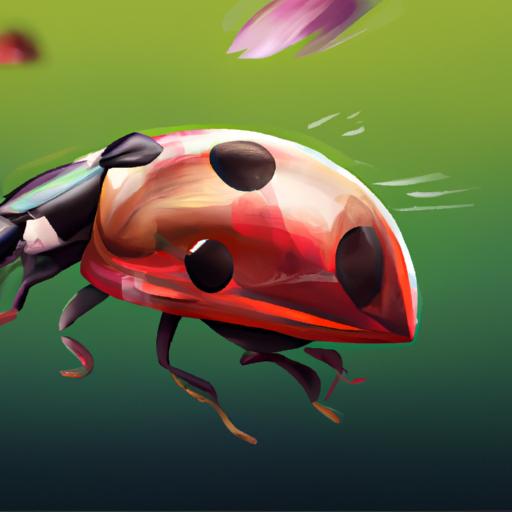Have you ever wondered why ladybugs are the bright, cheerful orange color that they are? Have you ever spotted one and thought to yourself “why orange?” Well, you’re not alone! We’ve got all the facts you need to know about why ladybugs are typically orange, and the answer may surprise you! Keep reading to find out why ladybugs are the color they are and what fascinating secrets they may be hiding.
Are Ladybugs Orange?
Ladybugs are usually orange or red in color, with black spots.
Other species, however, can have different colors and patterns.
This coloration serves to warn predators that the insect may taste bad or be toxic.
Additionally, the bright colors help the ladybug to spot similarly-colored prey, such as aphids.
The orange color of the ladybug is due to the pigments carotenoids, which are abundant in the ladybugs’ diet.
When the ladybug eats these carotenoids, they get stored in its fat cells.
During the process of shedding its exoskeleton, the carotenoids are released into the new layer of skin, giving the ladybug its signature orange color.
The color of a ladybug may also be affected by its environment.
Ladybugs living in colder climates tend to be darker in color, as the darker shades provide them with better camouflage.
Likewise, ladybugs living in warmer climates may be brighter in color, helping them to both attract mates and protect themselves from predators.
Overall, the bright orange color of a ladybug is the result of a combination of pigments stored in its fat cells, and environmental factors.
This color serves an important purpose, as it warns predators of its potential toxicity, as well as helping the insect to both find prey and attract mates.
What Is The Bug That Looks Like A Ladybug But Orange?

Have you seen a bug that looks like a ladybug but is orange? If so, it is likely a Harlequin Bug, also known as the Calico Bug.
This bug belongs to the family of True Bugs (Heteroptera) and is considered a pest of cruciferous crops, such as cabbage, broccoli, and kale.
Harlequin Bugs are usually shield-shaped with a black and orange coloration.
Even though they appear to be similar to the common Ladybugs, they have solid orange wing covers instead of the spotted wings of the Lady Beetle.
These bugs are found all over the world but are more common in the southern United States.
They feed on the leaves and stems of plants, and if left unchecked, can cause complete defoliation of crops.
Though Harlequin Bugs are considered to be a nuisance, they also can be beneficial as they feed on other pests, such as aphids and caterpillars.
By reducing the population of pest species, they help to maintain a healthy balance in the ecosystem.
If you need to get rid of Harlequin Bugs, it’s important to inspect your plants frequently and look for signs of infestation.
If you find an infestation, you can use a pesticide or an insecticide to get rid of them.
Additionally, it’s important to practice good gardening practices, such as rotating crops, to reduce the chances of an infestation occurring in the first place.
Can Regular Ladybugs Be Orange?
It is a common belief that regular ladybugs can be orange.
This is indeed true – ladybugs come in various sizes, shapes, and colors.
The most popular color for these beetles is orange, but they can also be seen in shades of red, yellow, and even white.
The color of a ladybug depends on its species – with over 400 species across the world, there is a great variety of colors to be seen.
Some species are always orange, while others may exhibit different colors depending on their age and environment.
The orange and black combination of the classic ladybug is believed to scare away predators.
The bright orange color makes it more visible, while the black color creates an intimidating look.
Ladybugs are amazing creatures, and it is fascinating to discover the different colors they can take on.
While orange and black is the most popular hue, you may come across other colors on occasion.
Are Orange Ladybugs Harmless?
Orange ladybugs are completely harmless to humans and animals.
These small beetles, also known as ladybirds, feed on small insects such as aphids and other soft-bodied bugs, helping to keep pests in check.
Depending on the species, they can have an orange body with black spots or be entirely orange.
This bright color is thought to be a warning sign to predators, letting them know that they may taste bad or be poisonous.
If you see an orange ladybug in your garden, you don’t have to be afraid.
Ladybugs don’t bite or sting, don’t carry any diseases and can even be beneficial in the garden.
Their ability to eat large numbers of pests can help to keep insect populations in check.
So, enjoy the presence of these small beetles in your garden and let them do their job!
Why Do I Have Orange Ladybugs In My House?

Orange Ladybugs, also known as Asian Lady Beetles, are commonly found inside homes across the United States.
These insects are looking for a warm and dry place to overwinter and may cause a nuisance once inside.
The cold temperatures and scarce food sources during the winter months may be the reason why these ladybugs have entered your home.
Homes can provide the perfect conditions for the ladybugs to survive these harsh conditions.
In addition, orange ladybugs may be attracted to the light coming from windows, doors, and other sources.
This can also draw them into your house.
Finally, small openings around windows and doors can provide an entry point for these ladybugs.
If these openings are not properly sealed, the ladybugs will find their way in and become a nuisance.
In conclusion, there are many reasons why orange ladybugs may have entered your home.
To prevent these pests in the future, you should address any entry points around windows and doors.
Additionally, reducing the amount of light around these areas can help to deter them.
Are Yellow Ladybugs Poisonous?
Yellow ladybugs are not poisonous.
Known as ladybirds or lady beetles, these types of beetles come in a variety of colors, including yellow.
While some ladybugs have a mild venom when they bite, it is not considered to be poisonous.
Usually, ladybugs will only bite humans if they are handled roughly or feel threatened.
Ladybugs are beneficial insects since they help to control pest populations in gardens, farms, and other areas.
They feed on aphids and other small insects that can damage crops, thereby helping the environment.
Additionally, they are admired for their bright colors, ranging from yellow to orange to red.
In conclusion, yellow ladybugs are not poisonous and are actually quite beneficial for the environment.
As long as they are not handled roughly, they pose no real threat to humans.
They also provide a valuable service in controlling pest populations in gardens and farms, making them highly beneficial to have around.
How To Get Rid Of Orange Ladybugs?
Getting rid of orange ladybugs can be tricky, but don’t worry there are a few steps you can take to rid your home of them.
Start by identifying where they are entering your home, such as around windows and doors.
If you find any, seal any cracks and crevices to prevent them from getting in.
Next, reduce the amount of food available to keep ladybugs away.
Remove any mulch, leaves, or dead plants from around your home ladybugs are attracted to these areas.
Switch to yellow bulbs for any outdoor lights ladybugs are drawn to bright lights, so yellow bulbs can help reduce their numbers.
You can also use insecticides or insect repellents containing pyrethrin, an insecticide effective against ladybugs.
Spray these products around the perimeter of your home or in areas where the ladybugs congregate.
Finally, set up traps to catch the ladybugs.
Make your own trap using a bucket filled with a mixture of soapy water and dishwashing liquid, and place it in an area near a window or door.
The ladybugs will be attracted to the light, get trapped in the bucket, and drown in the soapy water.
Follow these steps and you’ll be able to get rid of any orange ladybugs that are plaguing your home.
Final Thoughts
Ladybugs are typically orange due to their protective adaptation of warning coloration.
This adaptation allows them to ward off predators with their bright orange hue.
However, not all ladybugs are orange or even the same shape.
Some are yellow, red, or even black in color, and some are shaped like a shield.
With so much variety comes fascinating evolutionary secrets that scientists are still uncovering.
Now that you know why ladybugs are orange, take a look at some of the different species and shapes that exist.
You may be surprised at what you find!

